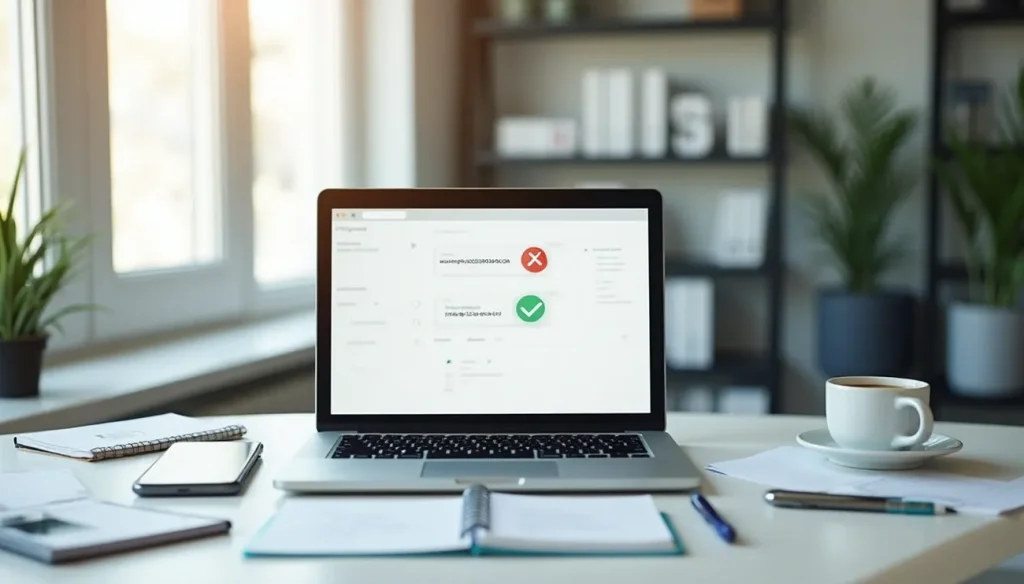Did you know that keeping your bounce rate below 5% is critical for your cold outreach campaigns to generate real results? An email checker will help you achieve exactly that, protecting the effectiveness of every email you make.
Verifying emails improves the quality of your databases and prevents invalid, outdated, or problematic addresses from contaminating your lists. When you use an email checking tool, you quickly identify which addresses can negatively affect your sender reputation. Remember that invalid emails generate hard bounces, increase the likelihood of being marked as spam, and drastically reduce the deliverability of your campaigns.
To verify large volumes of contacts, specialized tools perform syntactic checks, domain validation, and risk account detection automatically. This process lets you know if your list is ready to submit or needs debugging before launching your next campaign.
In this article, you’ll learn exactly how to use an email checker to clean your lists step by step. We’ll show you everything from selecting the most suitable tool to how to interpret the results to make decisions that significantly improve your delivery rates.
What is an email checker and why is it important?
An email checker is a tool that performs more than 25 tests in real-time to confirm if the addresses on your list actually exist and can receive messages. This software cross-checks the data with spam trap mails databases and uses SMTP verification to ensure the validity of each contact.
Prevent bounces and protect your reputation
Internet service providers constantly monitor bounces from your account. If they detect too many bounce emails, your reputation as a sender will deteriorate quickly.
To maintain a good sending reputation, your bounce rate should stay below 2%. Also consider that between 3% and 7% of emails on a list deteriorate every year. For databases of more than 1 million emails, it is recommended to validate them every 2 weeks, while for smaller ones, validating them once a quarter is enough.
Difference Between Verification and Validation
Although many people use these terms interchangeably, they represent distinct processes:
- Email validation: Checks the structure and syntax of an address – correct formatting, presence of the @ symbol, valid domain.
- Mail verification: It goes further and checks if the mail really exists and is active. It includes domain verification, DNS records, and SMTP testing to confirm that your mailbox can receive messages.
Both processes are complementary to maintain high-quality mailing lists.
How to know if an email address exists
You can check if an email exists in several ways without sending test messages:
- Specialized verification services: Tools like Verify Emails analyze each address and classify it as valid, risky, or invalid.
- Free online verifiers: Verifieremail also allows a limited number of daily verifications without registration.
Please note that some servers are configured to prevent checks as an anti-spam measure. However, regularly using a verifier significantly improves your deliverability and engagement rates, protecting the ROI of your campaigns.
If you are going to use email validation services on a regular basis, we recommend using the API to automate the entire verification process.
How an email verifier works
The email verification process is carried out on our servers through a series of automatic checks that analyze each email address. These systems run more than 25 different checks to determine if an address can safely receive messages.
Syntax and domain checking
The first step is to analyze the basic structure of each email address. The system verifies that it contains the essential elements: username, @ symbol and valid domain with corresponding extension.
After the syntax check is complete, the system checks if the domain is active and working properly. This check automatically deletes addresses associated with non-existent, expired, or inactive domains.
The format is then validated as compliant with RFC standards to ensure that the address can be processed correctly by mail servers.
SMTP Verification and MX Records
During this phase, the system queries the domain’s MX (Mail Exchange) records to identify which mail servers handle message delivery. For example, the value of Google’s MX record is smtp.google.com.
The verifier establishes a direct SMTP connection to the corresponding mail server to confirm that the specific address exists and can receive messages. This process simulates sending an email without actually delivering it.
We use different ranges of IPs to perform these checks, thus avoiding possible blocks by the target servers.
Detection of disposable emails and spam traps
Our system automatically identifies domains associated with temporary email services such as EmailOnDeck, 10 Minute Mail, and hundreds of other similar providers. These temporary addresses represent low-value contacts for your campaigns.
The check also detects potential spam trap mails, which are addresses created specifically to identify senders who do not follow good practices. There are three main categories:
- Pristine Traps: Addresses That Have Never Been Valid
- Recycled Traps: Former real addresses that were abandoned and reactivated as traps
- Typographic traps: Contain common errors in popular domains
Email verification is cross-referenced with our spam trap mails and bounces databases to ensure your list is completely clean before sending.
Step-by-step guide to using an email checker
Below, we’ll show you how to use a step-by-step email checker to effectively purge your contact lists. This process will allow you to get accurate results and maximize the quality of your database.
Step 1: Select the most suitable tool
To start, evaluate the available options considering the accuracy of the service. We recommend looking for tools with rates above 95% effectiveness in verification. Also, check that it offers integrations with your CRM or email marketing platform to automate the workflow.
Many platforms allow you to try the service at no cost – Verificaremails.com offers free verifications. Use this trial period to check if an email exists before signing up for a full subscription.
Step 2: Prepare and upload your contact file
Once the tool is selected, prepare your list in one of the most commonly accepted formats: CSV, XLS, XLSX, or TXT. The process is simple:
- Access the verification section of the platform
- Click “Import” or “Upload File”
- Specifies whether the first row contains column headers
- Turn on email notifications to receive alerts when the process is finished
Step 3: Analyze the results obtained
The system will automatically sort your contacts into different categories. The results are color-coded for easy interpretation:
- Green (Valid): Verified addresses that can receive emails
- Yellow (Unconfirmed): Addresses that might work, but their settings prevent full verification
- Red (Invalid): Non-existent or inactive addresses
Some tools include additional categories such as “available” for temporary emails, “role” for generic addresses (info@, soporte@), and “spam_traps” for addresses that can damage your reputation.
Step 4: Download your curated list
Finally, export the results according to your needs. Platforms usually offer these download options:
- Deliverables/Valid: Only addresses confirmed as secure
- All Results: Complete list with the status of each address
- Custom Results: Specific selection based on your criteria
Download the file in CSV or XLSX format to import it directly into your email marketing tool. Many platforms allow for automatic synchronization, eliminating additional manual steps.
Tips for Choosing the Best Verification Tool
To select an email verifier that really works for your business, you need to evaluate specific criteria that make the difference between an effective tool and one that generates mediocre results.
Accuracy and speed of service
Look for tools that guarantee rates above 98% accuracy. The best services on the market maintain a bounce rate of less than 2% for emails identified as valid, which directly protects your reputation as a sender.
Processing speed is equally important, especially if you handle extensive databases. The efficient tools process thousands of addresses per hour, allowing you to launch campaigns quickly without unnecessary waiting.
Integrations with your existing tools
We recommend choosing a solution that easily connects with your existing systems. The best options include native integrations with:
- CRMs: HubSpot, Salesforce, Zoho, Pipedrive
- Email marketing platforms: Mailchimp, SendPulse
- Automation: Zapier (connects with more than 1000 applications)
These integrations automate list cleaning, saving you valuable time that you can spend creating better campaigns.
Pricing options and free trials
For larger volumes, consider these options:
- Monthly subscriptions: Fixed payment for a set number of verifications
- Pay-as-you-go: You only pay for the checks made, it’s more flexible, and you have full control over costs.
The costs of Verifying Emails are one of the most competitive in the industry with the best cost/benefit ratio. You can see the prices to verify emails in the top menu of the website.
Security and Compliance
Verify that the tool processes data on servers located in the European Union to comply with GDPR. Key elements include:
- Encryption of uploaded data using SSL
- Secure communications via HTTPS
- Full control over the deletion of your data
- No international transfers of personal information
Remember that your contacts represent one of your most valuable assets, so security should not be negotiable.
Conclusion
Checking emails is simple and inexpensive, but it can make the difference between the success and failure of your marketing campaigns. Throughout this article, we’ve seen how to use an email checker step-by-step to maintain clean and effective lists.
Remember that email validation improves the effectiveness of email marketing campaigns by increasing their deliverability. When your database contains invalid emails, hard bounces, and spam trap mails, they negatively affect your reputation as a sender.
We recommend implementing regular checks of your contact lists. You can do this in bulk through files, individually with web applications, or by automating the entire process with APIs. Integrations with CRMs and email marketing platforms make this job much easier.
The investment of verifying your emails is recovered from the first campaign. A clean list directly translates to better open rates, higher engagement, and a higher return on investment.
Want to start getting better results from your campaigns? Get started today by checking your contact list. If you have any questions about the verification process or need help choosing the right tool, don’t hesitate to reach out to experts who can guide you through every step of the process.
FAQs
Q1. How can I check if an email address is valid?
You can use an email checker, which performs syntax, domain, and mailbox checks to confirm if an address exists and can receive messages. Some tools offer limited free verifications to test the service before subscribing.
Q2. What is the importance of maintaining a clean email list?
Maintaining a clean list is crucial to avoid bounces, protect your reputation as a sender, and improve deliverability rates. It is recommended to maintain a bounce rate below 5% to ensure the success of your email marketing campaigns.
Q3. What should I consider when choosing an email verification tool?
When selecting a verifier, consider factors such as accuracy (look for rates above 98%), processing speed, integrations with CRM and email platforms, pricing options and free plans, and compliance with regulations like GDPR.
Q4. How does the email verification process work?
The process includes syntax and domain checking, SMTP verification and MX records, and detection of disposable emails and spam traps. These stages allow you to identify invalid, risky, or potentially reputational addresses.
Q5. How often should I check my email list?
It’s estimated that between 3% and 7% of emails on a list deteriorate each year. Therefore, it’s advisable to perform regular checks, especially before major campaigns, to keep your list up to date and effective.




